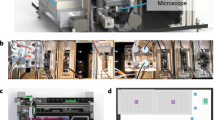Summary
A method of perfusion organ culture is described in which explants cultured at the airmedium interface are bathed by a continuous flow of nutrient medium. Morphological studies on the fetal rat lung indicate that explant development in this system is comparable to that obtained using standard organ-culture dishes. Medium supply is easily manipulated and continuous sampling of the effluent stream is possible without disturbing the immediate explant environment. The basic design facilitates secretory-response studies on cultured organ explants as demonstrated by a study of glucose-stimulated insulin release by the neonatal rat pancreas.
Similar content being viewed by others
References
Burr, I. M., W. Stauffacher, W. Balant, A. E. Renold, and G. M. Grodsky. 1969. Dynamic aspects of proinsulin release from perifused rat pancreas. Lancet 2: 882–883.
Rose, G. G.. 1967. The circumfusion system for multipurpose culture chambers. J. Cell Biol. 32: 89–112.
Murrell, L. R.. 1976. Circumfusion organ culture of rat acinar pancreas with chemically defined medium. In: M. Balls, and M. Monnickendam (Eds.),Organ Culture in Biomedical Research. Cambridge University Press, London, pp. 273–292.
Kruse, P. F., L. N. Keen, and W. L. Whittle. 1970. Some distinctive characteristics of high-density perfusion cultures of diverse cell types. In Vitro 6: 75–88.
Castor, L. N. 1968. Contact regulation of cell division in an epithelial-like line. J. Cell. Physiol. 72: 161–172.
Castor, L. N. 1973. Culture dish perfusion with cinemicrography. In: P. F. Kruse, and M. K. Patterson (Eds.),Tissue Culture: Methods and Applications. Academic Press, New York, pp. 298–303.
Burrows, M. T. 1912. A method of furnishing a continuous supply of new medium to a tissue culturein vitro. Anat. Rec. 6: 141–144.
De Haan, J. 1937–1938. The perfusion method for tissue culture in its latest form. Acta Neerl. Morphol. Norm. Pathol. 1: 12–23.
Rose, G. G. 1973. Dual-rotary circumfusion system. In: P. F. Kruse, and M. K. Patterson (Eds.),Tissue Culture: Methods and Applications. Academic Press, New York, pp. 283–291.
Kruse, P. F. 1972. Use of perfusion systems for growth of cell and tissue cultures. In: G. H. Rothblat, and V. J. Cristofalo (Eds.),Growth, Nutrition, and Metabolism of Cells in Culture. Vol. II. Academic Press, New York, pp. 11–66.
Patterson, M. K. 1975. Perfusion and mass culture systems. Procedure 08985 TCA Manual 1: 243–249.
Andrews, E. J. 1970. Toxicity of Millipore filter detergent to diffusion chamber cultures. Transplantation 10: 267–270.
Hirsch, J. G., and M. A. Fedorko. 1968. Ultrastructure of human leukocytes after simultaneous fixation with glutaraldehyde and osmium tetroxide and “postfixation” in uranyl acetate. J. Cell Biol. 38: 615.
Mollenhauer, H. H. 1964. Plastic embedding mixtures for use in electron microscopy. Stain Technol. 39: 111.
Trump, B. F., E. A. Smuckler, and E. P. Benditt. 1961. A method for staining epoxy sections for light microscopy. J. Ultrastruct. Res. 5: 343.
Gomori, G. 1950. Aldehyde fuchsin: A new stain for elastic tissue. Amer. J. Clin. Pathol. 20: 665–666.
McEvoy, R. C., and O. D. Hegre. 1976. Foetal rat pancreas in organ culture: Effects of media supplementation with various steroid hormones on the acinar and islet components. Differentiation 6: 105–111.
Morgan, C. R., and A. Lazarow. 1963. Immunoassay of insulin: Two antibody system. Plasma insulin levels of normal, subdiabetic, and diabetic rats. Diabetes 12:115–126.
Hoffman, W. S. 1937. A rapid photoelectric method for the determination of glucose in blood and urine. J. Biol. Chem. 120: 51–55.
Chen, J. M. 1954. The cultivation in fluid medium of organized liver, pancreas, and other tissue of foetal rats. Exp. Cell Res. 7: 518–529.
Shaffer, B. M. 1956. The culture of organs from the embryonic chick on cellulose-acetate fabric. Exp. Cell Res. 11: 244–248.
Trowell, O. A. 1954. A modified technique for organ culturein vitro. Exp. Cell Res. 6: 246–248.
McAteer, J. A., and O. D. Hegre. Manuscript in preparation.
Fell, H. B., and R. Robison. 1929. The growth, development and phosphatase activity of embryonic avian femora and limb-buds cultivatedin vitro. Biochem. J. 23: 767–784.
Lacy, P. E., E. H. Finke, S. Conant, and S. Naber. 1976. Long-term perifusion of isolated rat isletsin vitro. Diabetes 25: 484–493.
Cunningham, A. W. B., and B. D. Estborn. 1958. Chamber and flow system for quantitative tissue culture. Lab. Invest. 7: 156–162.
Schwartz, B. 1960. The design and performance of a perfusion system for the culture of the lens. Part II. AMA Arch. Ophthalmol. 63: 607–624.
Schwartz, P. L., R. E. H. Wettenhall, and J. Bornstein. 1968. The growth of newborn rat tibiae in a continuous flow organ culture system. J. Exp. Zool. 168: 517–530.
Stroud, A. N., F. Strasser, K. Finck, and F. H. Kasten. 1969. Use of spontaneously contracting mammalian myocardial cells in culture to test the influence of temperature change and drugs (abstr.) In Vitro 4: 68.
Knazek, R. A. 1974. Solid tissue masses formedin vitro from cells cultured on artificial capillaries. Fed. Proc. 33: 1978–1981.
Menezo, Y., M. Gerard, and C. Thibault. 1976. Culture du follicule de De Graaf de Bovin dans un système à courant liquid et gazeux continu. C. R. Acad. Sci. 283: 1309–1311.
Lindbergh C. A. 1939. A culture flask for the circulation of a large quantity of fluid medium. J. Exp. Med. 70: 231–238.
Langvad, E. 1970. The application of a tidal flow culture method to the study of histological and lactate dehydrogenase (LDH) isoenzymatic changes in primary mouse lung cell cultures. Acta Pathol. Microbiol. Scand. Sect. A 78: 487–504.
Murrell, L. R., K. H. Germain, and D. M. Lynch. 1975. Survival of functional pancreatic acinar tissue in circumfusion organ culture enhanced by chemically defined medium with hydrocortisone. Cancer Res. 35: 2286–2288.
Rose, G. G., M. Kumegawa, H. Nikai, M. Cattoni, and F. Hu. 1969. The HFH-18 mouse melanoma in roller tube, chamber, and circumfusion system cultures. Cancer Res. 29: 2010–2033.
Author information
Authors and Affiliations
Additional information
This work was supported by U. S. Public Health Service Training Grant No. GM 00114.
Rights and permissions
About this article
Cite this article
McAteer, J.A., Hegre, O.D. A continuous-flow method of organ culture. In Vitro 14, 795–803 (1978). https://doi.org/10.1007/BF02617974
Issue Date:
DOI: https://doi.org/10.1007/BF02617974




